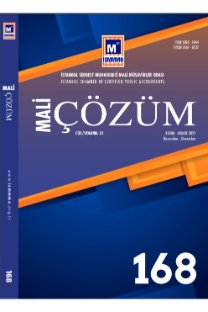Grup denetimlerinde bileşen önemlilik düzeylerinin belirlenmesinde guam modeli: macm modeliyle karşılaştırmalı bir uygulama
Bu çalışmanın amacı, grup denetimlerinde bileşen işletmelerin önemlilik düzeylerinin belirlenmesinde GUAM metodunun kullanımını göstermektir. GUAM bir Bayesyen olasılık modeli olup, denetim güvencesini Gamma olasılık dağılımlarına dayalı olarak göstermektedir. GUAM denetçilere etkin bir önemlilik sınırında, bileşenlerin önemlilik miktarları sunarak denetim çalışmalarında etkinliği ve verimliği sağlar. Çalışmanın amacına bağlı olarak Türkiyede faaliyet gösteren bir şirketler grubunun denetim çalışmasında GUAM modeli, alternatif model MACM ile karşılaştırmalı olarak uygulanarak, GUAMın kullanılabilirliği tartışılmıştır.
Guam model for assessing component materialities in group audits: A comparative application with macm model
This study aims to demonstrate the usage of GUAM model that assesses the component materiality in group audits. GUAM is a Bayesian probabilistic model which represents audit assurance based on Gamma probability distributions. GUAM provides effectiveness and efficiency in audit works by presenting components materiality amounts in an efficient materiality frontier. According to this study, usability of GUAM and MACM model were compared in an auditing application of a holding company in Turkey.
___
- American Institute of Certified Public Accountants (AICPA). 1972. Part of Audit Performed by Other Independent Auditors AU Section 543. New York : AICPA.
- American Institute of Certified Public Accountants (AICPA). 2006. Audit Risk and Materiality in Conducting an Audit. AU Section 312. New York : AICPA.
- American Institute of Certified Public Accountants (AICPA). 2008. Audit Sampling. Audit Guide. New York : AICPA.
- American Institute of Certified Public Accountants (AICPA). 2011. Speci- al Considerations-Audits of Group Financial Statements (Including the Work of Component Auditors). AU-C Section 600. New York : AICPA.
- Arens, Alvin A., Elder, Randal J., ve Beasley, Mark S. (2010) Auditing and Assurance Services: An Integrated Approach 13.bs. New Jersey : Pe- arson Prentice Hall.
- Boritz, Efrim, Zhang, Ping ve Aldersley, Steve (1993). On combining evidence from subpopulations into a composite conclusion Contemporary Accounting Research. 10 (1993): 227245.
- Dutta, Sankar ve Graham, Lynford (1998). Considering multiple mate- rialities for account combinations in audit planning and evaluation: A cost efficient approach Journal of Accounting, Auditing and Finance. Spring (1998):151-171.
- Felix, W. (1974 Nisan) A decision theory view of auditing. Contemporary Accounting Problems Arthur Andersen/University of Kansas Symposium on Auditing Problems, 6371. Lawrence, KS: University of Kansas Printing Service.
- Glover, S...[ve öte] (2008). Component materiality for group audits Journal of Accountancy. December (2008) : 42-46
- Glover, S. Ve ötekiler (2008). Component materiality for group audit- s:Probabilistic model Journal of Accountancy. December (2008) : 47-50
- International Auditing and Assurance Standards Board (IAASB). 2007. Special ConsiderationsAudits of Group Financial Statements (Including the Work of Component Auditors). International Standard on Auditing 600. New York, NY: International Federation of Accountants.
- International Auditing and Assurance Standards Board (IAASB). 2008. Materiality in Planning and Performing an Audit. International Stan- dard on Auditing 320. New York : International Federation of Accountants.
- Jaynes, Edwin Thompson (1957). Information theory and statistical mec- hanics The Physical Review. 106; 4 (1957): 620630.
- Johnson, Norman, Loyd, Kotz, Samuel ve Balakrishnan, Narayanaswamy (1994) Continuous Univariate Distributions Vol. 1, 2. bs. New York : John Wiley & Sons.
- Leslie, Donald (1985). Materiality: The concept and its application to auditing, The Canadian Institute of Chartered Accountants CICA Research Study, Toronto:Canada.
- OHagan, Andrew ve Forster, Jens (2004) Kendalls Advanced Theory of Statistics -Vol. 2B-Bayesian Inference 2.bs. London : Arnold.
- Rittenberg, Larry E., Schwieger, Bradley J., ve Johnstone, Karla M (2008) Auditing: A Business Risk Approach 6.bs. Mason,USA: Thomson South-Western.
- Smith, Fred T.M. (1976) Statistical Sampling for Accountants. London, U.K.: Haymarket.
- Steele, Anthony (1992) Audit Risk and Audit Evidence: The Bayesian Approach to Statistical Auditing, San Diego CA, USA: Academic Press.
- Stewart, Trevor (2008). Audit sampling. Technical notes on the AICPA audit guide. New York: AICPA.
- Stewart, Trevor ve William, R. Kinney (2013). Group audits, group-level controls and component materiality:How much auditing is enough ? Ameri- can Accounting Association. 88- 2 (2013):707-737
- Stewart, Trevor. (2011) A General Unified Assurance and Materiality Model with Application to Group Audits and Component Materiality, (Yayınlanmamış Doktora Tezi) Amsterdam,Vrije Universiteit.
- Teitlelbaum, Leslie ve Anderson, Rot (1979) Dollar Unit Sampling. To- ronto : Copp Clark Pitman.
- Thomas, William C. ve Wedemeyer, Phil D. (2013). Clarifying the stan- dard for group audits Journal of Accountancy. March (2013):33-39
- Turner, Jerry (1997). The impact of materiality decisions on financial rati- os: A computer simulation Journal of Accounting- Auditing and Finance. 12 (1997): 125147.
- Zhang, Jian, Pany, Kurt ve Pringle, Lynn. (2011). Group audits under AU 600: An overview of the effects of the new Standard CPA Journal-Accoun- ting &Auditing. May (2011) : 22-28
- Zuber, G. Ve ötekiler. (1983). Using materiality in audit planning Jour- nal of Accountancy. March (1983) : 42-54
- ISSN: 1303-5444
- Yayın Aralığı: Yılda 6 Sayı
- Başlangıç: 1991
- Yayıncı: İstanbul Serbest Muhasebeci Mali Müşavirler Odası
Sayıdaki Diğer Makaleler
Ufrs dipnot açıklama gerekliliklerine uyum: literatür araştırması
Yolsuzluk nedir? yolsuzluk çeşitleri ve ülkeler arası yolsuzluk algılaması
Mesleki tükenmişliğin muhasebe meslek mensuplarının etik tutumları üzerindeki etkisi
Ozan BÜYÜKYILMAZ, Serhan GÜRKAN
Kaliteli finansal raporlamada denetimin rolü ile ilgili tartışmalar
Çağnur Kaytmaz BALSARI, Seçil VARAN
